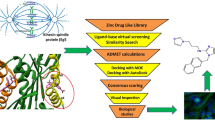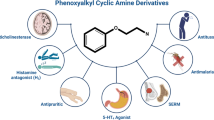Abstract
In this study, we investigated the structure-activity relationships of a series of β-carboline alkaloid derivatives using the 2D-QSAR and molecular docking, in order to identify the mode of interaction between β-carboline derivatives and the PLK1 kinase, and determine their key substituents responsible for the cytotoxic activity. The obtained QSAR models using multiple linear regression (MLR) and partial least squares (PLS) methods showed a high correlation between the experimental activity and the predicted one by PLS (R2PLS = 0.82, q2 = 0.72) and MLR (R2MLR = 0.82, q2 = 0.72). An external dataset was used to test the extrapolation power of the models which resulted in an R2PLS (EV) = 0.76; RMSE = 0.39. The 2D-QSAR analysis reveals that lipophilicity plays an important role in the cytotoxic activity of this group of β-carboline derivatives. Indeed, the molecular docking study into the active site of the polo-like kinase (PLK1) revealed that the most active ligand 57 shows higher binding energy and interacts, especially by H-bonds and hydrophobic interactions, with the active site of the PLK1 kinase. Consequently, the results obtained from the 2D-QSAR and docking studies provided a useful tool to design new and potent β-carboline derivatives as cytotoxic agents.






Similar content being viewed by others
References
Mohan K, Jeyachandran R, Deepa (2012) Alkaloids as anticancer agents. Ann Phytomed 1:46–53
Byler KG, Wang C, Setzer WN (2009) Quinoline alkaloids as intercalative topoisomerase inhibitors. J Mol Model 15:1417–1426. https://doi.org/10.1007/s00894-009-0501-6
Abramovitch RA, Spenser ID (2008) The carbolines. Adv Heterocycl Chem 3:79–207. https://doi.org/10.1016/S0065-2725(08)60542-5
Gilbert J, Senyuva HZ (2008) Bioactive compounds in foods. Blackwell Pub, Oxford
Aniszewski T (2015) Alkaloids: chemistry, biology, ecology, and applications2nd edn. Elsevier, Waltham, MA
Zheng W, Wang S, Barnes LF et al (2000) Determination of harmane and harmine in human blood using reversed-phased high-performance liquid chromatography and fluorescence detection. Anal Biochem 279:125–129. https://doi.org/10.1006/abio.1999.4456
Braestrup C, Nielsen M, Olsen CE (1980) Urinary and brain beta-carboline-3-carboxylates as potent inhibitors of brain benzodiazepine receptors. Proc Natl AcadSci 77:2288–2292
Schupp P, Poehner T, Edrada R et al (2003) Eudistomins W and X, two new β-carbolines from the micronesian tunicate Eudistoma sp. J Nat Prod 66:272–275. https://doi.org/10.1021/np020315n
Nazari Formagio AS, Santos PR, Zanoli K et al (2009) Synthesis and antiviral activity of β-carboline derivatives bearing a substituted carbohydrazide at C-3 against poliovirus and herpes simplex virus (HSV-1). Eur J Med Chem 44:4695–4701. https://doi.org/10.1016/j.ejmech.2009.07.005
Di Giorgio C, Delmas F, Ollivier E et al (2004) In vitro activity of the β-carboline alkaloids harmane, harmine, and harmaline toward parasites of the species Leishmaniainfantum. ExpParasitol 106:67–74. https://doi.org/10.1016/j.exppara.2004.04.002
Waki H, Park KW, Mitro N et al (2007) The small molecule harmine is an antidiabetic cell-type-specific regulator of PPARγ expression. Cell Metab 5:357–370. https://doi.org/10.1016/j.cmet.2007.03.010
Yamazaki Y, Kawano Y (2011) Inhibitory effects of herbal alkaloids on the tumor necrosis factor-α and nitric oxide production in lipopolysaccharide-stimulated RAW264 macrophages. Chem Pharm Bull (Tokyo) 59:388–391
Chen Q, Chao R, Chen H et al (2005) Antitumor and neurotoxic effects of novel harmine derivatives and structure-activity relationship analysis. Int J Cancer 114:675–682. https://doi.org/10.1002/ijc.20703
Cao R, Peng W, Chen H et al (2005) DNA binding properties of 9-substituted harmine derivatives. BiochemBiophys Res Commun 338:1557–1563. https://doi.org/10.1016/j.bbrc.2005.10.121
Cao R, Chen Q, Hou X et al (2004) Synthesis, acute toxicities, and antitumor effects of novel 9-substituted β-carboline derivatives. Bioorg Med Chem 12:4613–4623. https://doi.org/10.1016/j.bmc.2004.06.038
Pérez Martín JM, Labrador V, Fernández Freire P et al (2004) Ultrastructural changes induced in HeLa cells after phototoxic treatment with harmine. J ApplToxicol 24:197–201. https://doi.org/10.1002/jat.972
Song Y, Kesuma D, Wang J et al (2004) Specific inhibition of cyclin-dependent kinases and cell proliferation by harmine. BiochemBiophys Res Commun 317:128–132. https://doi.org/10.1016/j.bbrc.2004.03.019
Hamsa TP, Kuttan G (2011) Harmine activates intrinsic and extrinsic pathways of apoptosis in B16F-10 melanoma. Chin Med 6:11
Frédérick R, Bruyère C, Vancraeynest C et al (2012) Novel trisubstituted harmine derivatives with original in vitro anticancer activity. J Med Chem 55:6489–6501. https://doi.org/10.1021/jm300542e
Liu H, Han D, Liu Y et al (2013) Harmine hydrochloride inhibits Akt phosphorylation and depletes the pool of cancer stem-like cells of glioblastoma. J Neuro-Oncol 112:39–48. https://doi.org/10.1007/s11060-012-1034-x
Zhao L, Wink M (2013) Theβ-carboline alkaloid harmine inhibits telomerase activity of MCF-7 cells by down-regulating hTERT mRNA expression accompanied by an accelerated senescent phenotype. PeerJ 1:e174. https://doi.org/10.7717/peerj.174
Zhang H, Sun K, Ding J et al (2014) Harmine induces apoptosis and inhibits tumor cell proliferation, migration and invasion through down-regulation of cyclooxygenase-2 expression in gastric cancer. Phytomedicine 21:348–355. https://doi.org/10.1016/j.phymed.2013.09.007
Cao M-R, Li Q, Liu Z-L et al (2011) Harmine induces apoptosis in HepG2 cells via mitochondrial signaling pathway. Hepatobiliary Pancreat Dis Int 10:599–604. https://doi.org/10.1016/S1499-3872(11)60102-1
Dai F, Chen Y, Song Y et al (2012) A natural small molecule harmine inhibits angiogenesis and suppresses tumour growth through activation of p53 in endothelial cells. PLoS One 7:e52162. https://doi.org/10.1371/journal.pone.0052162
Hamsa TP, Kuttan G (2011) Studies on anti-metastatic and anti-invasive effects of harmine using highly metastatic murine B16F-10 melanoma cells. J Environ Pathol Toxicol Oncol 30:123–137. https://doi.org/10.1615/JEnvironPatholToxicolOncol.v30.i2.40
Chen Z, Cao R, Shi B et al (2011) Synthesis and biological evaluation of 1,9-disubstituted β-carbolines as potent DNA intercalating and cytotoxic agents. Eur J Med Chem 46:5127–5137. https://doi.org/10.1016/j.ejmech.2011.08.027
Bain J, Plater L, Elliott M et al (2007) The selectivity of protein kinase inhibitors: a further update. Biochem J 408:297–315. https://doi.org/10.1042/BJ20070797
Göckler N, Jofre G, Papadopoulos C et al (2009) Harmine specifically inhibits protein kinase DYRK1A and interferes with neurite formation: harmine, a specific inhibitor of DYRK1A. FEBS J 276:6324–6337. https://doi.org/10.1111/j.1742-4658.2009.07346.x
Adayev T, Wegiel J, Hwang Y-W (2011) Harmine is an ATP-competitive inhibitor for dual-specificity tyrosine phosphorylation-regulated kinase 1A (Dyrk1A). Arch BiochemBiophys 507:212–218. https://doi.org/10.1016/j.abb.2010.12.024
Sobhani AM, Ebrahimi S-A, Mahmoudian M (2002) An in vitro evaluation of human DNA topoisomerase I inhibition by Peganumharmala L. seeds extract and its beta-carboline alkaloids. J Pharm PharmSci 5:19–23
Cao R, Chen H, Peng W et al (2005) Design, synthesis and in vitro and in vivo antitumor activities of novel β-carboline derivatives. Eur J Med Chem 40:991–1001. https://doi.org/10.1016/j.ejmech.2005.04.008
Cao R, Guan X, Shi B et al (2010) Design, synthesis and 3D-QSAR of β-carboline derivatives as potent antitumor agents. Eur J Med Chem 45:2503–2515. https://doi.org/10.1016/j.ejmech.2010.02.036
Han X, Zhang J, Guo L et al (2012) A series of beta-carboline derivatives inhibit the kinase activity of PLKs. PLoS One 7:e46546. https://doi.org/10.1371/journal.pone.0046546
Lamchouri F, Settaf A, Cherrah Y et al (2000) In vitro cell-toxicity of Peganumharmala alkaloids on cancerous cell-lines. Fitoterapia 71:50–54
Lamchouri F, Toufik H, Elmalki Z et al (2013) Quantitative structure–activity relationship of antitumor and neurotoxic β-carbolines alkaloids: nine harmine derivatives. Res ChemIntermed 39:2219–2236. https://doi.org/10.1007/s11164-012-0752-1
Lamchouri F, Zemzami M, Jossang A et al (2013) Cytotoxicity of alkaloids isolated from Peganumharmala seeds. Pak J Pharm Sci 26:699–706
Lamchouri F, Toufik H, Bouzzine SM et al (2010) Experimental and computational study of biological activities of alkaloids isolated from Peganum harmala seeds. J Mater EnvSci 1:343–352
ChemAxon, MarvinSketch 2.1.0 (2016). http://www.chemaxon.com. Accessed 01 Dec 2017
Molecular Operating Environment software, Chemical Computing Group Inc., Montreal, Quebec, Canada. http://www.chemcomp.com/
Addinsoft (2014) XLSTAT: data analysis and statistical solution for microsoft excel. Paris, France. http://www.xlstat.com. Accessed 25 Feb 2017
Tropsha A (2010) Best practices for QSAR model development, validation, and exploitation. Mol Inform 29:476–488. https://doi.org/10.1002/minf.201000061
Dehmer M, Varmuza K, Bonchev D (2012) Statistical modelling of molecular descriptors in QSAR/QSPR: DEHMER:MOL. DESCRIPTOR O-BK. Wiley-VCH Verlag GmbH & Co. KGaA, Weinheim
Roy K (2007) On some aspects of validation of predictive quantitative structure–activity relationship models. Expert Opin Drug Discov 2:1567–1577. https://doi.org/10.1517/17460441.2.12.1567
Gramatica P (2007) Principles of QSAR models validation: internal and external. QSAR Comb Sci 26:694–701. https://doi.org/10.1002/qsar.200610151
Trott O, Olson AJ (2010) AutoDockVina: improving the speed and accuracy of docking with a new scoring function, efficient optimization, and multithreading. J ComputChem 31:455–461. https://doi.org/10.1002/jcc.21334
(2016) Dassault Systèmes BIOVIA, Discovery Studio Modeling Environment, Release 2017, San Diego: Dassault Systèmes. http://accelrys.com/products/collaborative-science/bioviadiscoverystudio/. accessed 01 Feb 2018
DeLano WL (2008) The PyMOL Molecular Graphics System, Version 2.0 Schrödinger, LLC. http://www.pymol.org. Accessed 01 Feb 2018
Consonni V, Ballabio D, Todeschini R (2010) Evaluation of model predictive ability by external validation techniques. J Chemom 24:194–201. https://doi.org/10.1002/cem.1290
Aptula AO, Jeliazkova NG, Schultz TW, Cronin MTD (2005) The better predictive model: high q2 for the training set or low root mean square error of prediction for the test set? QSAR Comb Sci 24:385–396. https://doi.org/10.1002/qsar.200430909
Gasteiger J, Marsili M (1980) Iterative partial equalization of orbital electronegativity—a rapid access to atomic charges. Tetrahedron 36:3219–3288. https://doi.org/10.1016/0040-4020(80)80168-2
Labute P (2000) A widely applicable set of descriptors. J Mol Graph Model 18:464–477. https://doi.org/10.1016/S1093-3263(00)00068-1
Author information
Authors and Affiliations
Corresponding authors
Ethics declarations
Conflict of interests
The authors declare that they have no conflict of interest.
Ethical approval
This chapter does not contain any studies with human participants or animals performed by any of the authors.
Rights and permissions
About this article
Cite this article
Akabli, T., Toufik, H., Yasri, A. et al. Combining ligand-based and structure-based drug design approaches to study the structure-activity relationships of a β-carboline derivative series. Struct Chem 29, 1637–1645 (2018). https://doi.org/10.1007/s11224-018-1141-1
Received:
Accepted:
Published:
Issue Date:
DOI: https://doi.org/10.1007/s11224-018-1141-1




